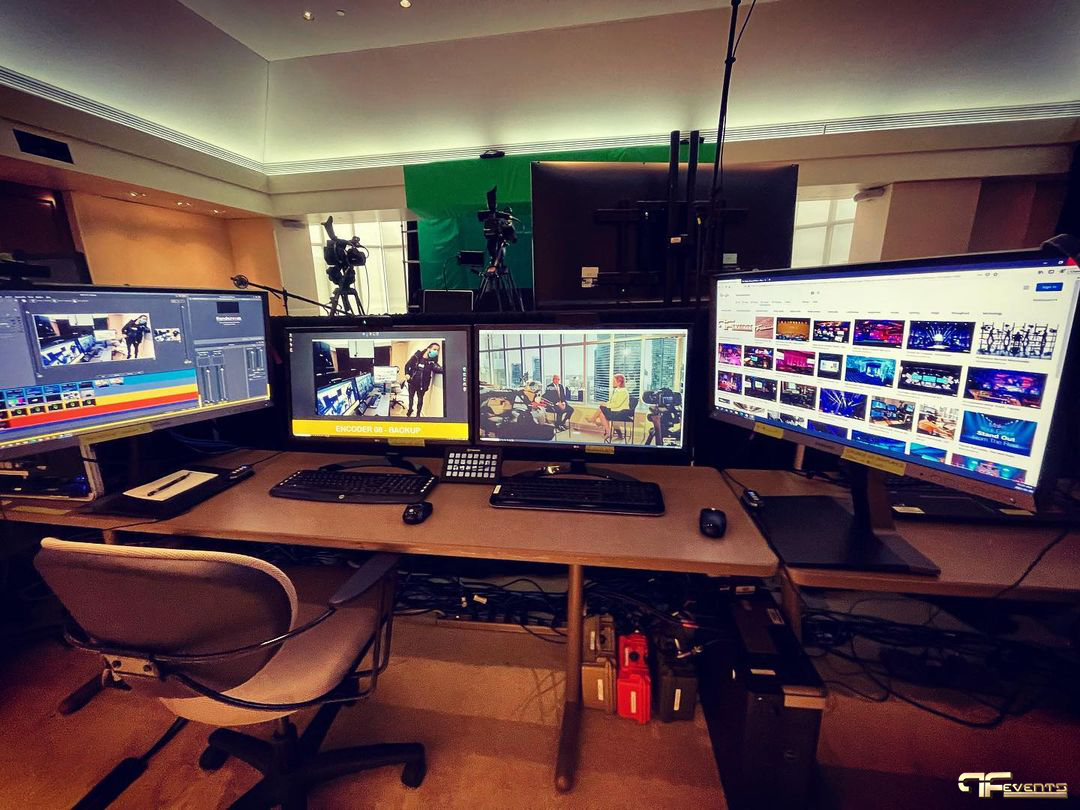
What is Virtual Event AV Production?
Virtual Event Production refers to the production and technological audiovisual (AV) used to produce a virtual or live event. While live events require a particular type of AV production, virtual events require their own skillset. Typically virtual event production may include services, equipment, training and staff with the right experience to provide an exceptional audiovisual experience for your events.
Why invest in the production of virtual AV events?
Whether you are producing a live event, a virtual event or a hybrid event – the audiovisual equipment and resources enhance the participants’ experience, the speaker experience and help support the behind-the-scenes team leading the event.
At the end of the day, virtual events are often held to a higher standard by both the organizers and the attendees. In this guide to differentiating virtual events, there are now more virtual events than ever before. On the one hand, it means that audiences are prepared and ready to jump into virtual experiences. On the other hand, it also means that the bar for virtual experiences has been raised.
Attendees expect great sounds, sharp video and any number of thriving media that help boost your message and make a unique engaging virtual experience.
Keep in mind that virtual events are complex. They include many sessions, speakers, and pieces of music that are broadcast live or on-demand – and they seek to facilitate the various ways in which your participants can engage with the content of the event.
While virtual events are an exciting arena that can be enhanced by the production of virtual events, certain types of events like happy virtual hours, one-on-one discussions or internal meetings may not require an additional production boost. Talk to your team about your event goals to determine if investing in a virtual event production team is the right fit for you.
Two well-known misconceptions about virtual events and AV production
Before diving into the guide, let’s look at some misconceptions about virtual events and AV production.
First, there is the misconception that because virtual events tend to be less costly to produce than personal events, there is no need to invest in producing high-quality events. This is a common mistake for virtual event organizers for the first time.
While virtual events can generally be less costly to produce, they are still maintained to high-quality standards by attendees and event organizers as virtual events become more common.
Second, as the production of virtual events increases in 2021, the distinction between webinars and virtual events has become more defined. With so many virtual events happening and with virtual events tending to last longer than webinars, participants have little tolerance for poorly produced events and can lose interest very quickly. A fully produced event helps to keep the audience engaged and to provide high-quality impact broadcast experiences.
Virtual events can be compared to TV and broadcast shows. Unlike webinars that last from 30 minutes to an hour, television broadcasting and television broadcasting give priority to both quality content and production. This means setting up resources for audio, visual and high-value effects that help keep viewers engaged in the content.
The AV Production Guide for Virtual Events
We have explained what AV production is, why it is valuable, and some common misconceptions about virtual events and AV production. Now, we can discuss how you can assess your AV production needs based on your virtual event goals, and how to secure those resources.
In this guide, we’ll cover:
- When You Should Consider AV Production
- AV Production Services and Resources
- Budget Considerations for AV Production
- Tips for Getting Started with AV Production Teams
When You Should Consider AV Production
There are many benefits to involving an AV production team in your next virtual event. Partnering with an AV production service can be a huge boost for resource-constrained teams, can enrich the speaker experience while onboard, test and transmit speakers and their content, and can provide a smoother experience, attractive and the best brand for your attendees.
Here are 5 cases where you want to seriously consider involving AV production resources:
- When your team has limited time and/or resources
- When you want to provide a broadcast level experience to your participants
- When a virtual event involves VIP speakers or a higher number of speakers
- When your event involves more than two sessions
- When an event requires multiple technical elements such as background music, pre-recorded videos, or visual transitions
- If your event satisfies any of the above criteria, you may want to consider investing in AV.
Tips for Getting Started with Your AV Production Team
Here are three easy ways to get started when partnering with an AV production team for a virtual event. For additional details, see how we started our first virtual summit.
- Understand the size and purpose of the virtual event you are looking to start by creating an AV production schedule. This schedule will help you determine your needs and will also serve as a guide for your production team.
- Start consultations early with your AV production team. There is a good chance that you will have to rehearse with them at least once (and potentially many times) to make sure everything goes smoothly.
- We also recommend setting up an open line of communication with your AV team through a chat app like Slack, Microsoft Teams, or WhatsApp. This can help ease questions before the event, but it is also very helpful to keep tabs on what is happening on the day of the event.
That’s all – now let’s move on to the main intakes from this guide.

Comments are closed.